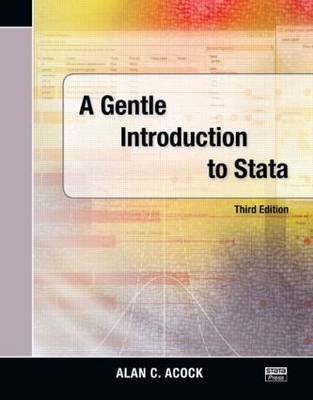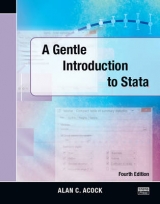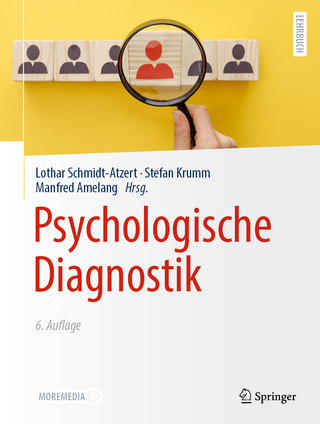
A Gentle Introduction to Stata, Third Edition
Stata Press (Verlag)
978-1-59718-075-7 (ISBN)
- Titel erscheint in neuer Auflage
- Artikel merken
New to the Third Edition
A new chapter on the analysis of missing data and the use of multiple-imputation methods
Extensive revision of the chapter on ANOVA
Additional material on the application of power analysis
The book covers data management; good work habits, including the use of basic do-files; basic exploratory statistics, including graphical displays; and analyses using the standard array of basic statistical tools, such as correlation, linear and logistic regression, and parametric and nonparametric tests of location and dispersion. Rather than splitting these topics by their Stata implementation, the material on graphics and postestimation are woven into the text in a natural fashion. The author teaches Stata commands by using the menus and dialog boxes while still stressing the value of do-files. Each chapter includes exercises and real data sets are used throughout.
Alan C. Acock is a University Distinguished Professor of Family Science and the Knudson Chair for Family Research in the College of Health and Human Sciences at Oregon State University. He has published more than 120 articles in leading social and behavioral sciences journals. Dr. Acock’s research interests encompass quantitative methodology and family studies.
Getting started
Conventions
Introduction
The Stata screen
Using an existing dataset
An example of a short Stata session
Summary
Exercises
Entering data
Creating a dataset
An example questionnaire
Develop a coding system
Entering data using the Data Editor
Value labels
The Variables Manager
The Data Editor (Browse) view
Saving your dataset
Checking the data
Summary
Exercises
Preparing data for analysis
Introduction
Planning your work
Creating value labels
Reverse-code variables
Creating and modifying variables
Creating scales
Save some of your data
Summary
Exercises
Working with commands, do-files, and results
Introduction
How Stata commands are constructed
Creating a do-file
Copying your results to a word processor
Logging your command file
Summary
Exercises
Descriptive statistics and graphs for one variable
Descriptive statistics and graphs
Where is the center of a distribution?
How dispersed is the distribution?
Statistics and graphs—unordered categories
Statistics and graphs—ordered categories and variables
Statistics and graphs—quantitative variables
Summary
Exercises
Statistics and graphs for two categorical variables
Relationship between categorical variables
Cross-tabulation
Chi-squared test
Degrees of freedom
Probability tables
Percentages and measures of association
Odds ratios when dependent variable has two categories
Ordered categorical variables
Interactive tables
Tables—linking categorical and quantitative variables
Power analysis when using a chi-squared test of significance
Summary
Exercises
Tests for one or two means
Introduction to tests for one or two means
Randomization
Random sampling
Hypotheses
One-sample test of a proportion
Two-sample test of a proportion
One-sample test of means
Two-sample test of group means
Testing for unequal variances
Repeated-measures t test
Power analysis
Nonparametric alternatives
Mann–Whitney two-sample rank-sum test
Nonparametric alternative: Median test
Summary
Exercises
Bivariate correlation and regression
Introduction to bivariate correlation and regression
Scattergrams
Plotting the regression line
Correlation
Regression
Spearman’s rho: Rank-order correlation for ordinal data
Summary
Exercises
Analysis of variance
The logic of one-way analysis of variance
ANOVA example
ANOVA example using survey data
A nonparametric alternative to ANOVA
Analysis of covariance
Two-way ANOVA
Repeated-measures design
Intraclass correlation—measuring agreement
Summary
Exercises
Multiple regression
Introduction to multiple regression
What is multiple regression?
The basic multiple regression command
Increment in R-squared: Semipartial correlations
Is the dependent variable normally distributed?
Are the residuals normally distributed?
Regression diagnostic statistics
Outliers and influential cases
Influential observations: DFbeta
Combinations of variables may cause problems
Weighted data
Categorical predictors and hierarchical regression
A shortcut for working with a categorical variable
Fundamentals of interaction
Power analysis in multiple regression
Summary
Exercises
Logistic regression
Introduction to logistic regression
An example
What is an odds ratio and a logit?
The odds ratio
The logit transformation
Data used in rest of chapter
Logistic regression
Hypothesis testing
Testing individual coefficients
Testing sets of coefficients
Nested logistic regressions
Power analysis when doing logistic regression
Summary
Exercises
Measurement, reliability, and validity
Overview of reliability and validity
Constructing a scale
Generating a mean score for each person
Reliability
Stability and test–retest reliability
Equivalence
Split-half and alpha reliability—internal consistency
Kuder–Richardson reliability for dichotomous items
Rater agreement—kappa (K)
Validity
Expert judgment
Criterion-related validity
Construct validity
Factor analysis
PCF analysis
Orthogonal rotation: Varimax
Oblique rotation: Promax
But we wanted one scale, not four scales
Scoring our variable
Summary
Exercises
Working with missing values—multiple imputation
The nature of the problem
Multiple imputation and its assumptions about the mechanism for missingness
What variables do we include when doing imputations?
Multiple imputation
A detailed example
Preliminary analysis
Setup and multiple-imputation stage
The analysis stage
For those who want an R2 and standardized ßs
When impossible values are imputed
Summary
Exercises
A What’s next?
Introduction to the appendix
Resources
Web resources
Books about Stata
Short courses
Acquiring data
Summary
References
Author index (pdf)
Subject index(pdf)
| Erscheint lt. Verlag | 9.9.2010 |
|---|---|
| Verlagsort | College Station |
| Sprache | englisch |
| Gewicht | 839 g |
| Themenwelt | Geisteswissenschaften ► Psychologie |
| Mathematik / Informatik ► Mathematik | |
| ISBN-10 | 1-59718-075-0 / 1597180750 |
| ISBN-13 | 978-1-59718-075-7 / 9781597180757 |
| Zustand | Neuware |
| Informationen gemäß Produktsicherheitsverordnung (GPSR) | |
| Haben Sie eine Frage zum Produkt? |
aus dem Bereich



